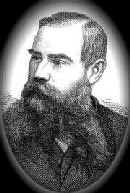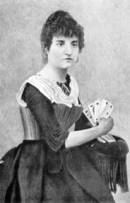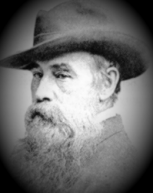Pagan Pioneers: Founders, Elders, Leaders
and Others
Charles Godfrey Leland

Written and compiled by George Knowles
Charles G. Leland was an American scholar, folklorist, humorist and prolific author who wrote
several classic books on English Gypsies and Italian Witches. These
include “Etruscan Roman Remains”, “Legends of Florence”, “The
Gypsies, “Gypsy Sorcery” and perhaps his most famous book “Aradia:
Gospel of the Witches.” During his time he wrote more than fifty
books on a variety subjects, and penned uncounted articles for many major
periodicals. His writings inspired the
likes of “Gerald B. Gardner” and “Doreen Valiente” as well as many other
pioneers of modern day Wicca/Witchcraft. In America he is also recognized
for his effort to establish Industrial Art as a branch of public education.
Born of old English
descent Leland’s ancestral lineage can be traced back to a “John Leland” who in
1530 was a chaplain and librarian to King Henry VIII. He is distinguished in that a special position was created for
him in 1533 when he became the first person to be appointed Royal Antiquary. Another distinguished ancestor is “Charles
Leland” who was Secretary of the Society of Antiquaries during the reign of
Charles 1. Other members of his linage moved to America in 1636 and were
prominent among the early pilgrims to settle in Massachusetts.
Leland was born to
parents Henry Leland and Charlotte Frost Godfrey in Philadelphia, Pennsylvania on the 15th of August
1824. His father Henry was a descendant
of Hopestill Leland, one of the first white settlers in New England. His mother on her side of the family often
referred to an ancestress that had married into “sorcery”. In his own memoirs Leland wrote: “My mother's opinion was that this was a
very strong case of atavism, and that the mysterious ancestor had cropped out
in me”. His parents were both
Episcopalians but during his early youth converted to Unitarianism and brought
Leland up in that belief. His parents
encouraged his curiosity and he was exposed to a variety of ideologies as he
grew up.
A few days after his
birth Leland’s Old Dutch nurse carried him up into the garret of their home and
performed a special ritual. She placed
upon his breast a Bible, a key and a knife, and then placed lighted candles,
money and a plate of salt at his head.
The purpose of the rite was to ensure he rise up in life to be lucky and
to become a scholar and a wizard. As a
child Leland suffered from a serious bout of a meningitis-like illness, which
continued to dog him throughout his early childhood. As a result he often appeared to be weak, nervous and frail. Later he grew to a strapping six-feet, and
enjoyed a vigorous adult lifestyle.
Leland grew up
fascinated with folklore and magick, as a child he had been regaled with
stories of ghosts, witches and fairies.
The family being prosperous, they lived in a household that employed
servants, from one (an Irish immigrant woman) he learned about fairies, and
from another (a black women working in the kitchen) he learned about
Voodoo. By the age of 6 or 7, Leland
was already familiar with his parent’s library and was a voracious reader; he
even memorized Prospero’s speeches from Shakespeare’s play ‘The Tempest’.
His interest in folklore and all things occult would occupy much of his adult
life.
Leland was first
educated in a series of private schools in Philadelphia and during the summer
stayed with cousins in the New England countryside to benefit his health. Although Leland was a great reader, he was a
poor student and hated school. His teachers, and even his father,
regarded him as stupid due to his extreme weakness in mathematics. Later he went on to Princeton University
where he studied languages, wrote poetry, and pursued a variety of
other interests, including Hermeticism, Neo-Platonism, and the writings of Rabelais
and Villon.
After graduating from
Princeton, his father financed his post-graduate studies and sent Leland to
Europe where he studied at the universities of Heidelberg and Munich before
moving on to the Sorbonne in Paris.
While in Paris, Leland played an active part in the French Revolution of
1848. As Captain of a group of Revolutionaries at the hotel where he was staying, he constructed barricades and fought on the streets of
Paris. Later
that year he returned to America after the money
his father had supplied ran out.
Back home in Philadelphia, Leland apprenticed for a time in a Law firm and
passed the Bar association exams to practice in Pennsylvania. Law however proved to mundane for his
adventurous spirit and in 1853 he opted for a career in journalism. During his years as a journalist, Leland wrote hundreds of essays, reviews and articles for some of the
major periodicals of the time, including Vanity Fair, Graham's
Magazine and the Knickerbocker Magazine. He also wrote for the Illustrated
News in New York, the Evening Bulletin in Philadelphia and eventually took on
editorial duties for the Philadelphia Press.

Photo of Leland published
in an article “Legend of Bernadus”, The Illustrated News, Jan 1853
In 1856 Leland married and became deeply devoted to his wife for the next 46 years “Eliza
Bella ‘Isabel’ Fisher”. While acting as
an editor for Graham’s Magazine, he published the first of his German-English
poems “Hans Breitmann's Party” (1857).
These he wrote in a mixture of German and broken English, imitating the
dialect and humour of the Philadelphia Germans (also called Pennsylvania
Dutch). Collectively they were first
published in the 1860’s and 1870’s and so popularized
Leland that he soon became a sought-after and prosperous writer. The poems were later collected in “The
Breitmann Ballads” (newly edited in 1895).
It was about this time in the late 1850’s during
the build up to the American Civil War of 1861-65, that Leland developed strong pro-Union sentiments
and founded the Continental Monthly, a pro-Union Army publication to
support their views. He coined the term
“emancipation” as an alternative to “abolition” in reference to the Union’s
anti-slavery position. After the war
broke out on the 12th April 1861, Leland enlisted in 1863 and joined
an emergency regiment at the Battle of Gettysburg. After the war ended Leland traveled
extensively throughout America developing his knowledge of folklore and the
occult. On one occasion he tried his hand at prospecting for oil and on another
while traveling through the old Wild West, he stayed for a short visit with
General Custer at Fort Harker.
During his travels he
lived and studied with the Algonquin Indians for months at a time recording
their stories, myths and legends. He
also studied the myths and legends of the Eskimos, the Finno-Ugric languages of
the Finns and Lapps, and delved into the anthropology of a number of Mongoloid
peoples. He found parallels in various
Norse and North American Indian myths in as much as the Algonquin Indian
stories could be related to Norse legends, he then developed a theory on their
themes. He postulated that certain
myths had spread from Greenland down to Canada and into Northeastern
America. Leland’s studies led him to
the conviction that the US did not have a meaningful legitimate folk ethos, and
maintained that the American Indians understood nature and spirituality better
than even Ralph Waldo Emerson or Walt Whitman.
In 1869 Leland’s father
died, and with the inheritance from his estate together with the income he was
generating from sales of his “Breitmann” poems, Leland abandoned journalism, being able finically to pursue his
interest in folklore, mysticism and the occult. In 1870 he moved to England and began his study of the English
Gypsies. Over the course of time he won
the confidence of the then “King of the Gypsies” in England, Matty Cooper. From Cooper, Leland learned to speak Romany
the language of the Gypsies, but it took many years before the Gypsy people
accepted him as one of their own. They
called him Romany Rye, meaning a non-Gypsy who associates with Gypsies.
While in England Leland
was profoundly impressed by the growing appreciation of the newly formed Arts
and Crafts movement inspired by the likes of the English reformer, poet and
designer William Morris. So impressed,
in 1879 Leland returned home to Philadelphia and established the Industrial Art School.
Initially it was a school to teach Art and Crafts to disadvantaged children
in Philadelphia, but became widely known later when it was visited and praised
by Oscar Wilde.
In a lecture given in
New York and reported in the Montreal Daily Witness on the 15th
May 15 1882, Wilde is quoted:
“I would have a workshop attached to every school...I
have seen only one such school in the United States, and the was in
Philadelphia, and was founded by my friend Leland. I stopped there yesterday, and have brought some of their work
here to show you”. In a letter to
Leland also in May 1882, now preserved at Yale University, Wilde wrote: “When I showed them the brass work and
the pretty bowl of wood with the bright arabesques at New York they applauded
to the echo, and I have received so many letters about it and congratulations
that your school will be known and honoured everywhere, and you yourself
recognised and honoured as one of the great pioneers and leaders of the art of
the future”.
As a result of his
efforts Leland unknowingly kick-started a popular resurgence of Arts and Crafts
in America and was an important influence on the Arts and Crafts movement. Later the Home Arts and Industries
Association was founded in imitation of his initiative. In 1883 Leland returned to England to
continue his studies on the Gypsies.
While traveling around Europe with his Gypsy friends, Leland also
discovered a secret language used by traveling tinkers called “Shelta”. During this time he wrote two classic books
on Gypsies and established himself as the leading authority on the
subject. Later in 1888, Leland founded
and became the first President of the Gypsy-Lore Society.
In the winter of 1888
Leland moved to Florence in Italy, where he lived for the rest of his
life. It was here he began an in-depth
study of “Stregheria” or Italian Witchcraft.
His greatest source of information came from a mysterious lady called “Maddalena”,
who worked as a Tarot reader telling fortunes in the back streets of
Florence. Leland believed her to be a
practicing hereditary witch and employed her as his research assistant. She in turn introduced him to another Tuscan
witch called “Marietta”, who also helped to provide material for his research.
Leland was particular
interested to learn about old medical treatments and magical rituals performed
by witches across the rural areas of Tuscany.
Many of the treatments he found to be similar to those used by the
ancient Etruscan Civilizations of the early centuries BC. Passed down orally from generation to
generation many of these age-old treatments were still being used at the
beginning of the 20th century.
They included common treatments for dreams, toothaches, eye problems,
headaches, bladder stones, colic and most all types of bodily pains.
Overtime Maddelena
passed on to him more than 200 pages of written folklore, incantations and
stories. Later Leland wrote that her
memory seemed inexhaustible, and that the incantations she had learned seemed
endless. He also felt sure that the
incantations were originally Etruscan.
Although it took her ten years to do so, it was Maddalena who eventually
provided Leland with the material he needed for his most famous book “Aradia:
Gospel of the Witches”.

Maddalena
Leland was a prolific collector and
spent most of his spare time collecting Witch lore and purchasing items of
antiquity. One of his most prized
possessions was the “Black Stone of the Voodoos”. It is believed that there are only five or
six of these stones, or “conjuring stones” existing in the whole of
America. The stones are small black
pebbles thought to have originally arrived from Africa during the slave trade,
and whoever succeeds in obtaining one would become a Master of Voodoo
recognized as such by all other Voodoo practitioners in America. Leland somehow obtained one and this he
exhibited at the Folk-Lore Congress in London during 1891.

Surviving the death of his beloved
wife Isabel on the 09th July 1902, Leland himself died on the 20th
of March 1903 in Florence. He had
suffered with ill health for the pervious seven years, and toward the end a
bout of pneumonia and resulting heart problems caused his death. Leland was cremated in Florence and his
ashes returned to America, where they were buried at The Woodlands Cemetery,
Philadelphia, PA.



Photo’s
courtesy of Raven
Gramassi
Elizabeth Robins Pennell, Leland’s
niece who inherited much of his notes, letters and unpublished materials, wrote
a two-volume biography on him: “Charles Godfrey Leland: a Biography” (published in Boston by Houghton, Mifflin and Co in
1906). Her biography is filled with
comments on his early passionate interests in Witchcraft, Magic and the Occult,
of his passion she writes:
“As might be expected
of the man who was called “Master” by the Witches and Gypsies, and whose
pockets were always full of charms and amulets, who owned the Black Stone of
the Voodoo’s, who could not see a bit of red string at his feet and not pick it
up, or find a pebble with an hole in it and not add it to his store – who in a
word, not only studied witchcraft with the impersonal curiosity of the scholar,
but practiced with the zest of the initiated”.
Sadly Leland departed
without completing his work on Italian Witchcraft, however his legacy lives on
through his books. Until his time, no other books existed claiming to
contain material obtained directly from a practicing witch. His book “Aradia:
Gospel of the Witches” became one of the most influential works to affect
and influence modern day Wicca/Witchcraft and Paganism. It is also one of
the few books on Witchcraft to remain in print for over one hundred years.
End
A select bibliography:
1855: Meister Karl's Sketch-book
1855: Mystery of Dreams
1856: Piaui es of Travel
1862: Sunshine in Thought
1862: Heine's Book of Songs
1864: Legends of Birds
1870: Music Lesson of Confucius
1871: Hans Breitmann Ballads
1872: Pidgin-English Sing-Song
1873: The English Gipsies
1873: Egyptian Sketch Book
1879: Johnnykin and the Goblins
1879: Life of Abraham Lincoln
1880: The Minor Arts
1882: The Gypsies
1883: Industrial Education
1884: Algonquin Legends of
New England
1889: A Dictionary of Slang (with
Albert Barrerre)
1891: Gyspsy Sorcery and Fortune Telling
1892: The Hundred Riddles of the Fairy Bellaria
1892: Etruscan Roman Remains in Popular Tradition
1893: Memoirs
1895: The Breitmann Ballads (newly edited)
1895: Songs of the Sea and Lays of
the Land
1896: Legends of Florence Collected from the People (2
vols.)
1897: Hundred Profitable Acts
1899: Unpublished Legends of Virgil
1899: Aradia, or the Gospel of the Witches
1899: Have You a Strong Will?
1901: Legends of Virgil
1902: Flaxius, or Leaves from the Life of an Immortal
1903: Kuloskap the Master, and other
Algonquin Poems (with J. Dyneley Prince)
Book sources:
Encyclopedia of Wicca & Witchcraft - By Raven Gramassi
An ABC of Witchcraft Past and
Present - By Doreen Valiente
A History of Witchcraft (Sorcerers,
Heretics and Pagans) - By Jeffrey B. Russell
The Triumph of the Moon - By
Ronald Hutton
Drawing Down the Moon - By
Margot Adler
The Encyclopedia of Witches &
Witchcraft - Rosemary Ellen Guiley
Website sources:
http://en.wikipedia.org/wiki/Charles_Godfrey_Leland
http://www.themystica.com/mystica/pages/people.htm
First published on the 04th
May 2001, 21:44:50 © George Knowles






